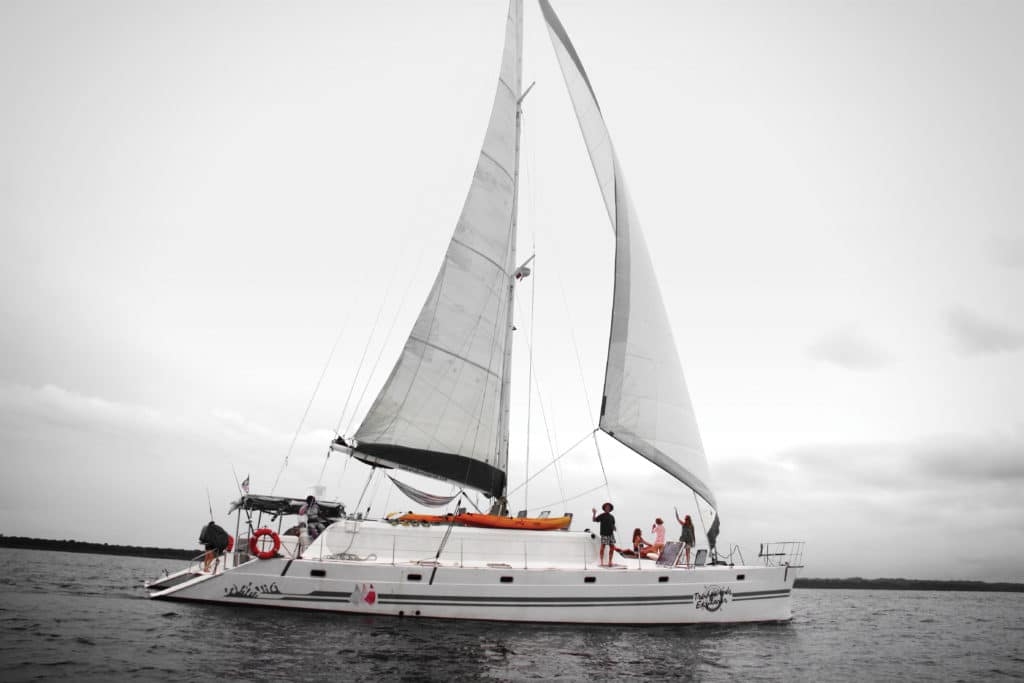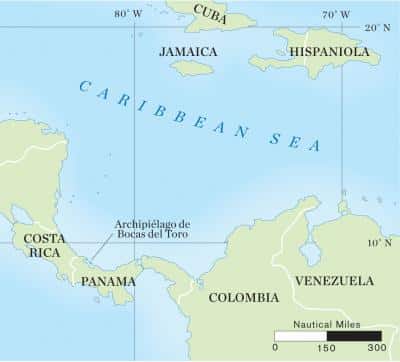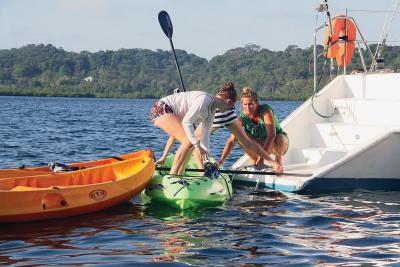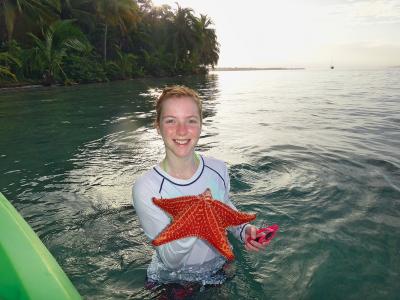
Book-by-Cabin Charters
If you’d told me a year ago I’d be afloat in the Bocas del Toro islands of Panama on a luxury catamaran, pampered by crew, and thoroughly awed by lush surroundings while snorkeling, kayaking and sailing with wonderful mates —among them twin teenage girls—I’d have told you point blank: You’re nuts.
What a difference a year makes. And what opportunities book-by-cabin charters can offer. My new mates, Melissa and Elizabeth, led the action and antics at every anchorage we visited in the low-lying archipelago, which is situated on the Caribbean Sea side of the Isthmus of Panama, in the northwest corner near Costa Rica. A destination well known to the backpacking and surfing set, Bocas del Toro has gained modest yet increasing attention from sailors over the last 25 years.
While its cruiser amenities today are as complete as in more heavily frequented locations in the Eastern Caribbean, Bocas—with its nine main islands, two good-size bays, countless mangrove cays, endless anchorages, well-developed coral reefs and chubby, plentiful starfish—remains relatively quiet, laid back and off the beaten path.
So though my other half, Rick Martell, and I didn’t really know what it would be like to sail with kids in a new cruising ground that we wanted to experience, we hopped aboard. This was a one-week trip organized by TradeWinds, which offers cabin charters in global destinations. The head count on board included three crew, two adult couples and, of course, the girls, who possessed a flawless sixth sense about when down time was in order.

The girls weren’t just quick witted; they were patient. After much trial and error and gulping of salt water, I managed to learn from Melissa how to wakeboard off the beach the day we anchored at idyllic Zapatillo Cay. At Laguna Porras, we got off the boat one morning and made a shore visit to a cacao plantation called Green Acres. While I followed the lead of its owner, Dave Cerutti, as he began to munch on protein-rich termites that he’d scooped out of the base of a tree, the girls scampered off and hid in the trunks of enormous tropical hardwoods. No tantrums, no complaints, no wires or ear buds draped around their necks— wonderful.
Throughout the week, they delved with as much focused appetite into their diary entries and their books as they did the chocolate milkshakes and delicious meals so beautifully prepared by the crew of our big cat, the TradeWinds Explorer.
The twins took gold-star status for being the mates who made the most of sailing for a week aboard the spacious, 70-foot-long, 30-foot-wide Royal Cape cat. At night, when the stars shone crisp and unfettered by urban light, while the howler monkeys called and the birds chirped in song, they even turned the foredeck trampoline into their stage, delighting the rest of us with a dance and light show as the Spastic Sea Cucumber and Starfish Crew. We liked it so much we requested a repeat performance the next night.
Since I’ve come home, the most frequent question I’m asked by every sailor I tell about that fabulous trip doesn’t concern cost, locale, sailing or food. No. The question that pops up right away about book-by-cabin charters, also called stateroom charters, is “How do you go sailing with people you don’t know?”
The notion of plunking down cash to complete strangers to score a berth on a sailboat and take to sea is nothing new. As a segment of the charter market, by-the-cabin bookings have existed for decades, mainly as flotillas in which individuals, couples and families can gain experience, socialize or tour new places. You can even pay on a by-the-berth basis and acquire demanding offshore passagemaking skills through various companies, brokers and individual boat owners.
More recently, cabin charters have gained traction with companies offering a variety of vacations aboard monohulls and multihulls that aren’t necessarily sailing in a convoy. Some trips are focused on the sailing, with a casual atmosphere and shared responsibilities. Others offer the services of a crew: prepared meals, open bar, and water- and land-based activities. Still others combine learning with socializing and cultural tours. Windjammer fleets also offer per-cabin bookings. Aboard all categories, individuals are as welcome as couples and are likely to pay 65 to 75 percent of the double occupancy rate; options for private cabins for individuals, some with heads, do exist. TradeWinds, the company we sailed with, borrows from the time-share model of its parent corporation to offer sailors a variety of charter vacation membership options as well as per-trip cabin bookings to nonmembers.
Believe it or not, companies and brokers don’t gaze into a crystal ball to match clients aboard. While boat availability is a factor, prospective guests are asked in advance to fill out forms that will uncover expectations and a range of details, from food allergies to sailing experience and activity preferences.

| |TradeWinds crew member Jannica Schenk helps Melissa and Elizabeth Linsdell deploy the kayaks during their weeklong charter.|
Some companies also insist on phone conversations to keep the process personal and get a better idea of clients’ likes and dislikes. Skippers, cooks and stewardesses of crewed boats are retained by companies by virtue of their track record, and by how well their qualifications jell with clients’ desires. TradeWinds actually sends its crews to school for six weeks to learn a range of client-service skills, including food prep and onboard dynamics.
“The first night of the charter, everyone’s full of anxiety when they come aboard,” said Jannica Schenk, the service manager who was on Explorer with us in Panama. “They get rid of this anxiety the first night. We’ve had guests who’ve met each other through us, and come back with the same group.” Several factors compel sailors to pursue these trips: They’re on a budget and a schedule; they can’t fill an entire boat but don’t want to be alone; they don’t want the responsibility to captain the boat; or they want to explore new places and meet new people while under way. For nearly 30 years, CW magazine has offered that experience through its Adventure Charter program, with per-person rates on bareboats and crewed boats in global destinations.
Still others want to use their free time to learn more formally about sailing. For nearly 50 years, Offshore Sailing School, the official school of the Moorings charter company, has offered live-aboard cruising courses and flotillas for graduates of its curriculum, all at a per-cabin rate for families, couples and individuals. So in all but extreme cases, companies, brokers and trip organizers are well skilled at taking matters of budget, time and client expectations and goals into consideration when matching boat, crew and paying guests.
“You cannot not have a good time,” says broker Dennis Dori of Charter Sailing Unlimited. “If the boat’s taken care of and the crew is working hard you are going to have a good time.”
Skipper David Kory has organized and led several flotillas a year in the United States and abroad for the American Sailing Association, which has offered formal instruction, certification and trips through its own curriculum for 30 years.
“Despite many sailors being independent in nature, sometimes it’s nice to let someone else worry about all the details, and this is the appeal of a flotilla,” he says. “So far, there’ve been no mutinies, but there’ve been two weddings as a result of people meeting on my trips.”
Back on board Explorer the final morning of our charter, I interrupted Elizabeth, who’d sought out solitude on the foredeck so she could read and write. She’d carefully logged the underwater life we’d seen, and I, too lazy to bother, now urgently wanted to crib from her notes before we went our separate ways.
I scoped out a fish and reef reference book from the boat’s library and sat down with her. Below, tomato and egg sandwiches called Portholes were being whipped up in the galley. The aroma wafted forward as we came up with this list:

| |Elizabeth shows off a treasure from her snorkeling outing, which she gently releases back to its home waters.|
“Tetra, sergeant major, damselfish, gobie, needlefish, wrasse, puffer fish, barracuda, parrotfish, white sea urchin, angelfish, butterfly fish, nurse shark, chub, zebrafish, grunt, shiners, red snapper, staghorn coral, sponge brittle star, schoolmaster snapper, tube sponge, brain coral, jack, hermit crab, feather duster, anemone, fire coral, moray eel, yellow tang, lionfish, sea nettle, flying fish, bat ray, spotted eagle ray, red squirrel fish, tang—“Oh! there’s Dory,” Elizabeth said, pointing at the blue fish on the page.
“From Finding Nemo, right?” I said. “Hey,” I added, “don’t forget the sea cucumbers and starfish.”This half of the Spastic Sea Cucumber and Starfish Crew smiled, and scribbled away. Wonderful this trip still was, and it happened because I wanted to sail someplace new, couldn’t do it on my own, and took a chance about hanging out with a couple of kids and their folks. I’m so glad I did.
Book-by-Cabin Guide
Fees: Per-trip family, couple, single, peak season and low season rates are available. A range of $2,000 to $8,000 per cabin, double occupancy, is normal. Airfare usually isn’t included; inquire. All-inclusive may or may not include cabin cost, alcohol, water toys, cruising fees, permits, taxes, tour and activity costs, or meals. Always ask for detailed list of all costs. Crew tips are never included in the quoted rate. They can run from 10 to 20 percent of trip cost.
Type: Fully crewed; skipper only; bareboat flotilla; instructional flotilla; windjammer/tall ship; offshore voyage.
Locations: Book-by-cabin charters are available worldwide, including in the United States, Bahamas, Caribbean, Mediterranean, South Pacific and Indian oceans, and Southeast Asia. Check with the company or a broker for those that interest you.
Boat and cabin type and size: Monohulls, multihulls, production models and custom makes are offered.
Catamarans can range from 40 to 82 feet, and monohulls from 40 to 80 feet. Monohulls can include windjammer schooners in Maine and traditional Turkish motorsailers called gulets in the Med, where marinas often can’t accommodate the beam of a cat. Three to 12 cabins in a boat is typical, depending on vessel size. Clients should view boat layout in advance to understand what type of space and accommodations they are paying for. Is the head private or shared? If in the tropics, is the cabin air-conditioned? If two individuals who aren’t a couple share a cabin, is it acceptable for one to sleep in the saloon? Ask about the age of the boat and try to charter one with less than five years of use.
Client ratio: Six to eight guests and one to three crew is ideal for boats from 40 to 80 feet. For formal instruction in liveaboard courses, four to six students per instructor is reasonable.
Itinerary: While the sailing route is usually fixed by the captain to provide a balanced day of activity and relaxation, guests are briefed on the day’s anticipated course and may provide feedback. Weather is always a factor. Consult the company or broker in advance for activities like diving, kite surfing and land tour options to find out what’s possible. Expect additional fees.
Term: Seven-night charters are the norm; 10-day trips are also popular.
Companies offering cabin charters include:
Catamaran Company
Dream Yacht Charter
Festiva
Moorings
Poseidon
TradeWinds
Brokers who arrange cabin charters include:
Charter Sailing Unlimited
King Yacht Charters
Nicholson Yachts Worldwide
Sail Connections
Others offering trips include:
CW Adventure Charters Offered by CW magazine in partnership with King Yacht Charters
American Sailing Association domestic and international flotillas
Steve and Doris Colgate’s Offshore Sailing School
Adventure Voyaging domestic and international flotillas
Maine Windjammer Association Down East trips offered aboard unique traditional schooners








